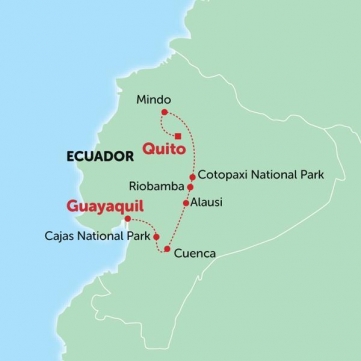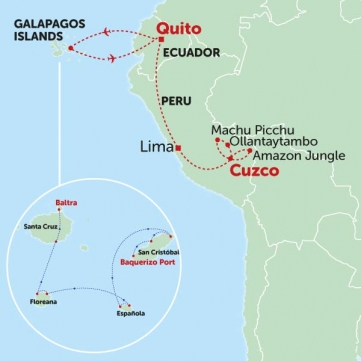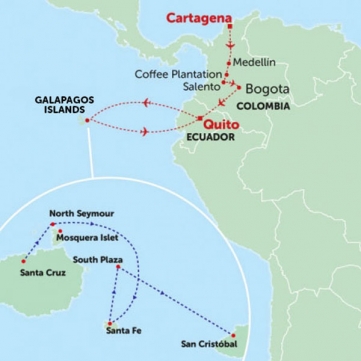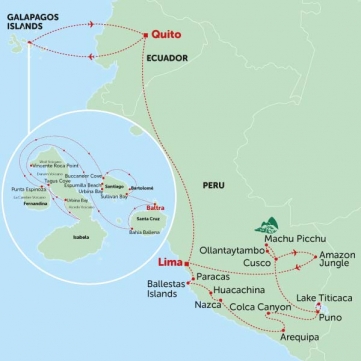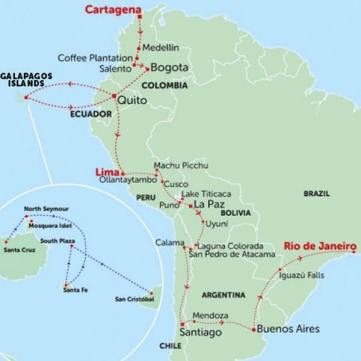Book NOW for $1 £1 €1 • Flexible Payments • No Change Fees • Private Departures Available
- Home >>
- Destinations >>
- South America >>
- Ecuador
Ecuador Tours
The second smallest country of South America offers diversity second to none. An Ecuador adventure tour takes you from the tropical cloud forest of the Amazon Jungle to the snow-capped peaks of the Andes, and from the colourful crafts market of Otavalo to the bustling colonial city of Quito with its beautifully preserved Spanish architecture, there is plenty to see and do here. Enjoy meeting the colourful local indigenous population on local buses and see how they live in the lovely towns and villages we pass along the way. Our Ecuador adventure tours visit the Amazon rainforest for a unique trip into this rich and diverse ecosystem. In Baños, which means “baths” in Spanish, enjoy a soak in the thermal springs or hike in the surrounding hills with its wonderful mountain views and array of adventure activities.
Get up close and personal with some of the world’s tamest and most unique animals on a Galápagos Island cruise. The unique wildlife may include birds like blue-footed and red-footed boobies, marine iguanas which can be seen diving into the waves to eat algae or sea lions which show no fear of humans and are often happy swimming with you as you snorkel. An Ecuador adventure tour never fails to please so don’t miss a visit to this fascinating country.
Featured Tours
Ecuador Travel Articles, Inspiration & Information
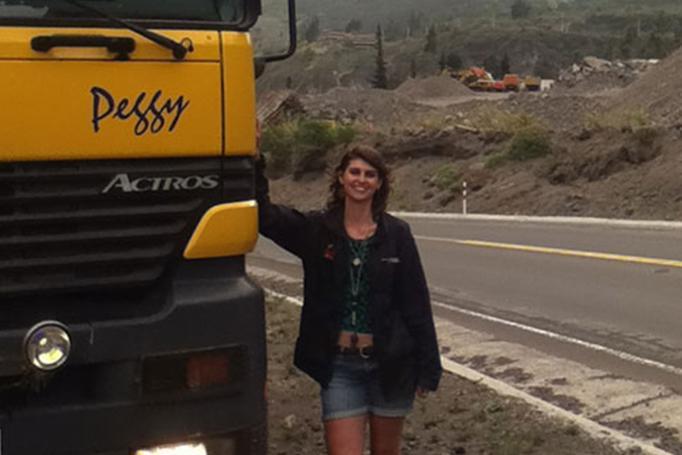
Tungurahua Volcano erupts just outside Baños
Boom! I woke briefly, sleepily wondered what the noise was, then quickly fell back asleep. After years of being on the road, and living in noisy cities, I am an awesome sleeper. It wasn’t until about an hour later, when I stumbled out of my tent, and saw an unusual mist in the air, did I realize anything of significance had happened. Tungurahua Volcano was erupting! Read more
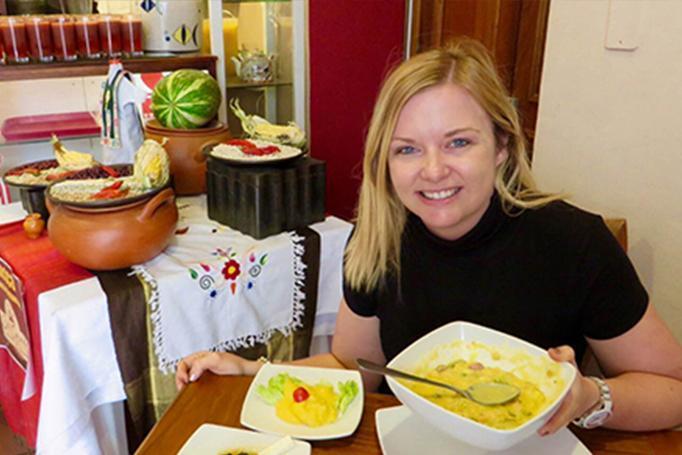
Feasting on Fanesca – Easter in Ecuador
Easter is a great time to visit Ecuador! With such a large Catholic population, the week known as Holy Week, from Palm Sunday to Easter Sunday, is a time of celebration and it is common to come across festivals, parades and street music. But this Easter I discovered another benefit to being in Ecuador during holy week – Fanesca! Read more
Independently Verified Travel Reviews From Past Clients
Ecuador Travel Guide
Ecuador Travel Guide
Ecuador is a compact nation densely packed with natural and cultural wonders that make it a delightful and manageable travel destination. Within the borders of this diminutive nation you can climb snow-peaked volcanoes, hike through cloud forest, explore the Amazon basin, surf the Pacific, wander cobbled colonial streets, snorkel with sea lions, barter in indigenous markets and marvel at Inca ruins... And that's just scratching the surface. Ecuador is known for its diversity, both geographically and culturally. It is home to many indigenous cultures with more than a dozen distinct groups speaking over 20 languages, some of whom still live primitive, traditional lives. Its equatorial climate makes it pleasant year round and its geographical landscape encompasses everything from Andean mountain ranges, jungle, beaches and of course the wildlife Mecca that is the Galapagos archipelago.
Money
In order to stabilise the economy, Ecuador undertook a process of dollarisation in 2000 which changed its official currency from the local sucre, to the US dollar. US dollar notes are the same as those used in the United States. Coins are the same denominations and size as in the United States but feature famous Ecuadorians and both US coins and Ecuadorian coins are accepted as legal tender. In addition, US Sacajawea $1 coins are in circulation and are legal tender
US dollars used in Ecuador are identical to those used in the United States and are available from ATMs which can be found in cities and most towns. It is a good idea to carry your travel funds in a mixture of US dollars and cards and ensure your card has a four-digit pin number in order to be able to use it at card machines. Larger notes, such as US$20, can be difficult to change unless making a bigger purchase, so try to carry smaller notes with you. Changing $50 and $100 notes will be next to impossible outside of banks.
Prices have risen since the currency was changed to the US dollar, but Ecuador is still an inexpensive destination for travellers. A basic set lunch is around $2-3.50 and mid-range dinner about $5-9. The highest cost is likely to be activities and excursions such as hiking, diving, mountaineering and mountain biking. Tipping is generally 10% for restaurant service where a service charge has not already been added to your bill. Local tour guides and drivers should also be tipped if they provided a good service.
Major Cities and Towns in Ecuador
Ecuador's capital city is Quito located in the central/north-west of the country. Its narrow labyrinthine alleys, picturesque churches, plazas, museums and markets make it a popular destination and the most common first stop on a trip to Ecuador. North of Quito is the market town of Otavalo which has hosted one of the most important Andean markets for hundreds of years. South of Quito, Ecuador's most spectacular volcanoes are located including Cotopaxi and Chimborazo. Near here is the popular spa town Baños and further south is the beautiful colonial city of Cuenca, a UNESCO World Heritage Site. From Cuenca it is possible to visit the Inca ruins of Ingapirca. The eastern third of the nation is called the Oriente and contains much of Ecuador's biodiversity, Andean mountain ranges and jungle. Many of the cities and towns here service the oil industry and are not particularly picturesque. The jungle town of Tena is a popular adventure spot and welcoming backpacker spot, as is the spa town of Baños. On the coast, Guayaquil is Ecuador's most populous city and major port and there are a number of surf and resort towns including Salinas and Atacames.
Electricity
Electricity supply in Ecuador is 110 volts and they use two flat pronged plugs such as is found in North America.
Etiquette and Culture
Around a quarter of Ecuador's population is indigenous and Ecuador is home to over a dozen distinct ethnic groups, the largest of which is Quichua (or Quechua in Peru) who speak Quichua as their first language. The majority is mestizo, people of mixed European and indigenous lineage which make up about 65% of the population. The remaining is made up of European, Afro-Ecuadorian and Asian. The country is overwhelmingly Roman Catholic with 95% of the population following Catholicism.
Ecuador's official language is Spanish and even Quichua and other indigenous people will usually speak Spanish alongside their own tongue unless they are very isolated. Greetings a very important in Ecuador and when speaking with shop owners, hotel staff, etc, it is polite to say '¿buenos dias, como estas?' before beginning a conversation. Men will usually greet each other with a handshake and women with a kiss on the cheek. Note, indigenous communities do not generally greet each other with a kiss.
Geography
Ecuador is located on the equator, giving it a consistent climate year round. It is around the same size as New Zealand and somewhat larger than the United Kingdom and borders with Peru, Colombia and the Pacific Ocean. Through the centre of the country, the Andean mountain range runs north to south splitting the nation in two with the highlands and coastal lowlands to the west and the jungle of the Amazon Basin to the east. The central highlands contain two parallel volcanic mountain ranges. This region is also the most densely populated in the country. The coastal lowlands include fruit plantations, agriculture and still retain some virgin rainforest. Ecuador's beaches have warm water year round and it is possible to surf. The Galapagos Islands are an archipelago that belong to Ecuador and are made of volcanic rock.
History
Ecuador's earliest permanent settlements began around 6000 years ago. Ecuador's earliest cultures included the Valdivia who were famous for their pottery, and the Chorrea and Machalilla who practised skull deformation. By around 600 BC society began to become more ordered and stratified with long-distance trade and ruling shaman/merchant classes. This pattern continued, with cultures integrating into larger, hierarchical societies. By the time the Incas arrived in the 15th century, the main groups were the Caras (also called the Quitu-Caras or Shyris), Puruhá and the Cañari.
The Inca Empire began expanding from their origin in the Cuzco valley in Peru in the early 15th century. When they reached Ecuador they were met with fierce resistance from the local people. When the Incas finally conquered, they massacred thousands of Caras throwing their bodies into a lake near Otavalo which was later named Laguna Yaguarcocha – lake of blood. The Incas consolidated their control of the area through marriage and children with local princesses but there were many uprisings. This was not helped by the divisions within the Inca Empire itself. When Inca ruler Huayna Capa left the empire to his two sons, Atahualpa (who was raised in Quito) and Huáscar (based in La Paz), the rivalry between them led to civil war.
Atahualpa eventually defeated his brother but the empire was much weaker than it had previously been and when the Spanish conquistadors arrived in 1532 it took a mere handful of men to wrest control of the area and bring the empire under colonial rule. The Spaniards, led by Francisco Pizarro, captured Atahualpa at a meeting intended for negotiations and proceeded to ransom him for extortionate amounts of gold and silver before conducting a sham trial and executing him.
Ecuador was under colonial control from 1535 ruled by the viceroyalty of Lima and was a peaceful colony where agriculture and arts flourished. It was transferred to the viceroyalty of Colombia in 1739 which at the time was known as Nueva Grenada. By the mid-18th century treatment of indigenous people and mestizos was terrible in a system that encouraged force labour and there were several indigenous uprisings. The first attempt at independence was in 1809 but it wasn't until Venezuelan liberator Simon Bolivar arrived in 1820 that independence began to become a reality. Two years later in the Battle of Pichincha, the royalists were finally defeated. Bolivar combined Venezuela, Colombia and Ecuador in one united nation called Gran Colombia, but this only lasted until 1830 at which point Ecuador became fully independent.
Ecuador's political development was volatile, although it never had the violent military coups experienced in other South American countries. Governments were chopped and changed and presidents rarely had the opportunity to complete their term in office. Between 1930 and 1940, 17 presidents tried to lead the country and not one ruled for a full term. Oil was discovered in 1967 and became a key export. Ecuador started to borrow money in the belief that the profits from oil would allow it to repay its debts. Slumping oil prices in 1986 along with an earthquake in 1987 that took out 40% of the pipeline damaged the economy. In 1997-8 another oil price slump and devastating diseases that took out 80% of shrimp exports led to massive inflation which topped out at 60%. To stabilise its spiralling economy, Ecuador took the US dollar as its official currency (previously the sucre) and adopted austerity measures in order to obtain financial aid from the IMF. In 2006, US-educated economist and previous finance minister Rafael Correa was voted into power whose focus is social welfare, improving life for Ecuador's poor and reforming the economy.
Best time to travel in Ecuador
Seasons
Ecuador is a year round destination. Its position on the equator means that temperatures do not differ greatly throughout the year and other seasonal variations are dependent on regional geographic features. There are four climatic zones in the country – the Galapagos Islands, the coast, the highlands (including Quito) and the Oriente (including the Ecuadorian Amazon) – each of which have their own weather patterns. Generally speaking the dry season is from June to September and the rainy season is from October to May.
The highlands including Quito is drier and cooler from June to September although the temperature only really varies by a few degrees throughout the year. Due to its high altitude, Quito can be cool throughout the year and has an average maximum temperatures of 10 (min) and 19 (max) degrees C.
The Amazon Jungle is hot and wet year round. It gets more rain between April and July and its driest months are August to September and December to February. That said, you are likely to have rain at any time of year, so the Amazon Jungle can be visited year round.
The coast receives most of its rainfall between January and May. This is also when it is sunniest and clearest (except for the afternoon showers) making this time of year the peak tourist season. This is also the peak season for the Galapagos Islands, when the air and water temperatures are warmer. The rest of the year sees more cool, dry, overcast weather.
When to travel
Weather-wise Ecuador is seasonable year round. On the mainland, Ecuador's high season is June to September when its best to book well in advance and the low season is December to May. In the Galapagos Islands this is practically reversed; December to May is the high season when the temperatures are warmer and seas are calmer and clearer. From June to November the islands low season has cooler, drier weather and slightly rougher seas.
In the Galapagos Islands, every month has a different wildlife highlight. In January, green sea turtles start laying their eggs, in May the blue-footed boobies begin their famous courtship dances, August and September a good months to see baby sea lions and in November there may be a chance to see whale sharks in the far north-west. Every season there is something happening!
Back on the mainland, there are a few annual celebrations that are worth keeping in mind. One of the biggest festivals of the highlands is the Mama Negra procession in Latacunga which includes hundreds of costumed dancers and happens in September. Ecuador has its own version of Carnaval which falls sometime in February or March each year. Semana Santa (Easter) is marked with religious processions through the streets.
Guide to food in Ecuador
Ecuador's cuisine has evolved as a result of the range of produce available within its diverse geographical regions and it is a blend of Spanish colonial influence and traditional indigenous recipes. Typical ingredients include maiz (corn), potatoes, quinoa, cuy (guinea pig) and pork in the highland regions and seafood, shrimp, plantains and bananas. In the interior of the country in the Ecuadorian Amazon, staples include yuca, plantain, river fish, chicken and beef. If you are offered to eat jungle creatures such as monkey or turtle it is best to refuse as hunting these animals makes them endangered. Dishes you may want to look out for when you are travelling in Ecuador include:
Tamales, humitas and quimbolitos
These are all made from cornmeal flavoured and wrapped in corn husks and steamed. Humitas are lightly sweetened corn dumplings and quimbolitos are sweeter, cake-like dumplings.
Soups
These include locro which are creamy and hearty, caldos and sopa which are broth-based, sancochos which are stew-like and secos which are stews served over rice.
Fish-based dishes
Found on the coast, the most widely available is corvina which is white fish, ceviche, a selection of fish and seafood marinated in lemon juice, herbs and thinly sliced onions and seafood soups such as encebollado which is a seafood and onion broth poured over yuca. Encocado is an African-influenced dish served in the north of fish or shrimp cooked in a spiced coconut sauce.
Top Attractions and Highlights in Ecuador
1. Quito
This high Andean capital is known for its colonial architecture and historical monuments. Its old town has been declared a UNESCO World Heritage Listed Site. Explore the cobblestone lanes at leisure or wander one of the city's fascinating museums.
2. The Galapagos Islands
A volcanic archipelago in the Pacific Ocean, famous for its diverse wildlife much of which has very little fear of humans. Snorkel with turtles and sea lions. See rays, sharks and reptiles as well as an extraordinary array of birdlife. With many endemic species, the Galapagos Islands are a dream for wildlife lovers.
3. Otavalo
Home to one of the most important indigenous markets in the Andes, Otavalo comes alive during its weekly fair when vendors trade woven textiles, carved wooden artefacts, street food and more. Indigenous people wear traditional clothing and mingle with visitors at this cultural crossroads.
4. Ingapirca
Ingapirca is Ecuador's only major Inca ruins and its best preserved archaeological site. It offers a snapshot of Incan domination over the indigenous Cañari people and allows visitors to wander freely through the complex which includes the Temple of the Sun.
5. Cuenca
A beautiful colonial mountain town and UNESCO World Heritage Site, Cuenca dates back to the 16th century and has cobbled streets and colourful buildings. It is also where the famous Panama hat was first made (not in Panama as many believe!) and is the ideal place to purchase your own beautifully hand-woven piece.
6. The Pacific Coast
Ecuador's southern coast is the place for surf and sun. Sandy beaches and coastal resorts characterise this part of the country and Ecuador's equatorial climate ensures mild weather year round and with warm waters. Perfect for relaxing after a jaunt in the Amazon Jungle, or hike up one of Ecuador's volcanoes!
7. Amazon Jungle
Much of the eastern third of the country is dominated by the Ecuadorian Amazon, an area of mega-diversity with 50% of Ecuador's species of mammal and 5% of the earth's plant species. Watch monkeys cavort amongst the canopy and keep your eyes peeled for the ever elusive jaguar. Staying in one of Ecuador's excellent jungle lodges allows full immersion in this exotic, tangled landscape.
8. Cotopaxi Volcano
South of Quito in the central highlands, the landscape becomes volcanic with sulphur-tinged lakes and snow-dusted conical peaks. The most famous of these is Cotopaxi Volcano whose surrounding park offers hiking and mountain biking opportunities as well as wildlife watching with foxes, llamas, Andean condor and wild horses living around its base.
9. Baños
What could be more exciting than a hot spring town in the shadow of a volcano that occasionally spits fire and smoke? Baños, with its steaming thermal pools and surrounding jungle-draped peaks, is a magnet for adventure seekers as well as those just looking for a relaxing break. Surrounding wilderness offers hiking, biking, rafting, climbing and horse-back riding and the town's chilled back atmosphere makes it a welcoming spot.
10 Interesting Facts about Ecuador
1. Ecuador has the highest population density in South America with roughly 49 people per square kilometre. Despite this there are still vast swathes of wilderness as over half the population live in built up urban areas.
2. Quito is located at an altitude of 2950 metres making it the second highest capital city in the world after La Paz, Bolivia.
3. Ecuador is the world's largest exporter of bananas, but petroleum is the export on which they are most reliant accounting for over half the country's export earnings.
4. The national sport is football (soccer) and Ecuadorians are very passionate about the game. When Ecuador qualified for the World Cup for the first time in 2002 and again in 2005 there were parties throughout the country which continued through the night and into the next morning.
5. For 100 years, Ecuador was part of the Inca Empire which spanned Ecuador, Peru and Bolivia. Quito became the second capital of the Inca Empire and the Incas introduced the Quichua language to the area, brought new crops such as cocoa and the sweet potato and built an extensive network of roads.
6. In 2008, following a referendum, Ecuador drafted bold amendments to its constitution to prohibit discrimination, allow civil unions for gay couples, increase spending on healthcare and the poor, increase rights for indigenous people and focus on protecting the environment.
7. In 1929 Ecuador became the first country in South America to give women equal voting rights.
8. Due to the earth's equatorial bulge, Ecuador's Cotopaxi Volcano is the world's furthest point from the centre of the earth and the closest point on earth to the sun.
9. Bird-watching is a very popular reason for visiting Ecuador as the country has over 1600 species of birds which is more than North America and Europe combined.
10. Ecuador's first national park was the Galapagos Islands, established in 1959. It now has over thirty parks which are protected and cover 18% of Ecuador's total land area. Despite this, ecologists say that Ecuador has the worst environmental record and highest deforestation rates on the continent.



